Journal Description
International Journal of Financial Studies
International Journal of Financial Studies
is an international, peer-reviewed, scholarly open access journal on financial market, instruments, policy, and management research published quarterly online by MDPI.
- Open Access— free for readers, with article processing charges (APC) paid by authors or their institutions.
- High Visibility: indexed within Scopus, ESCI (Web of Science), EconLit, EconBiz, RePEc, and other databases.
- Journal Rank: JCR - Q2 (Business, Finance) / CiteScore - Q2 (Finance)
- Rapid Publication: manuscripts are peer-reviewed and a first decision is provided to authors approximately 24.8 days after submission; acceptance to publication is undertaken in 3.6 days (median values for papers published in this journal in the second half of 2024).
- Recognition of Reviewers: reviewers who provide timely, thorough peer-review reports receive vouchers entitling them to a discount on the APC of their next publication in any MDPI journal, in appreciation of the work done.
Impact Factor:
2.1 (2023);
5-Year Impact Factor:
2.1 (2023)
Latest Articles
The Inflationary Episode of 1603 in Light of the Austrian Economic Theory
Int. J. Financial Stud. 2025, 13(2), 89; https://doi.org/10.3390/ijfs13020089 - 22 May 2025
Abstract
This paper examines the inflationary episode of 1603 in Spain through the lens of Austrian Economic Theory. The study focuses on the effects of monetary expansion caused by the influx of precious metals from the Americas and its impact on real wages and
[...] Read more.
This paper examines the inflationary episode of 1603 in Spain through the lens of Austrian Economic Theory. The study focuses on the effects of monetary expansion caused by the influx of precious metals from the Americas and its impact on real wages and raw material prices. Through the analysis of historical data and the application of statistical methods, this study identifies key relationships between monetary inflows, price levels, and income distribution. The findings indicate that the rapid expansion of the money supply triggered inflation, disproportionately impacting various sectors of society. Using the Cantillon Effect as a framework, the study explains how monetary expansion led to uneven wealth redistribution and production distortions. Additionally, the Austrian Business Cycle Theory highlights the consequences of artificial monetary growth, including the misallocation of resources and reduced purchasing power for wage earners. This study employs historical data from Edward J. Hamilton and other sources, utilizing normalization techniques and regression models to empirically examine the economic dynamics of this period. By bridging theoretical insights with empirical analysis, this paper contributes to a deeper understanding of early modern inflationary processes and offers lessons applicable to contemporary economic challenges.
Full article
(This article belongs to the Special Issue Financial Stability in Light of Market Fluctuations)
►
Show Figures
Open AccessArticle
Is the ESG Score Part of the Set of Information Available to Investors? A Conditional Version of the Green Capital Asset Pricing Model
by
Lucía Galicia-Sanguino and Rubén Lago-Balsalobre
Int. J. Financial Stud. 2025, 13(2), 88; https://doi.org/10.3390/ijfs13020088 - 21 May 2025
Abstract
In this paper, we propose a linear factor model that incorporates investor preferences toward sustainability to analyze indirect effects that climate concerns may have on asset prices. Our approach is based on the relationship between environmental, social, and governance (ESG) investing and climate
[...] Read more.
In this paper, we propose a linear factor model that incorporates investor preferences toward sustainability to analyze indirect effects that climate concerns may have on asset prices. Our approach is based on the relationship between environmental, social, and governance (ESG) investing and climate change considerations by investors. We use ESG scores as a part of the information set used by investors to determine the unconditional version of the conditional capital asset pricing model (CAPM). Our results show that the ESG score allows the linearized version of the conditional CAPM to greatly outperform the classic CAPM and the Fama–French three-factor model for different sorts of stock portfolios, contributing significantly to reducing pricing errors. Furthermore, we find a negative price of risk for stocks that covary positively with ESG growth, which suggests that green assets may perform better than brown ones if ESG concerns suddenly become more pressing over time. Thus, our paper constitutes a step forward in the attempt to shed light on how climate change is priced regardless of the climate risk measure used.
Full article
Open AccessReview
From Tweets to Trades: A Bibliometric and Systematic Review of Social Media’s Influence on Cryptocurrency
by
Sheela Sundarasen and Farida Saleem
Int. J. Financial Stud. 2025, 13(2), 87; https://doi.org/10.3390/ijfs13020087 - 19 May 2025
Abstract
The rise of social media has significantly influenced the cryptocurrency market, driving volatility through sentiment-driven trading. This study employs a bibliometric and content analysis approach to examine how social media, particularly Twitter, impacts cryptocurrency price movements. Using the bibliometric analysis, 151 peer-reviewed articles
[...] Read more.
The rise of social media has significantly influenced the cryptocurrency market, driving volatility through sentiment-driven trading. This study employs a bibliometric and content analysis approach to examine how social media, particularly Twitter, impacts cryptocurrency price movements. Using the bibliometric analysis, 151 peer-reviewed articles published between 2018 and 2024 were analyzed to identify key research trends, themes, and potential future research. This study finds that social media sentiment plays a crucial role in cryptocurrency price forecasting, with machine learning and natural language processing (NLP) techniques enhancing prediction accuracy. Thematic analysis reveals four primary areas of focus: sentiment analysis and market prediction, machine learning-driven algorithmic trading, blockchain investment risks, and influencer-driven market behavior. This study contributes to the field by consolidating existing social media sentiment and cryptocurrency valuation knowledge, offering insights to investors, regulators, and academics. It highlights the need for future research to integrate multi-platform sentiment analysis, regulatory considerations, and behavioral finance perspectives. These insights are vital for understanding the evolving landscape of digital asset markets and their susceptibility to sentiment-driven speculation.
Full article
(This article belongs to the Special Issue Cryptocurrency and Financial Market)
►▼
Show Figures

Figure 1
Open AccessArticle
Firm Profitability and Economic Crises: The Non-Linear Role of the Cash Conversion Cycle
by
Agim Kukeli, Benjamin Widner, Fitim Deari, Gevorg Sargsyan and Nicoleta Barbuta-Misu
Int. J. Financial Stud. 2025, 13(2), 86; https://doi.org/10.3390/ijfs13020086 - 14 May 2025
Abstract
►▼
Show Figures
This study investigates the non-linear effect of the cash conversion cycle (CCC) on a firm’s profitability for a sample of 6072 firms from five countries (Germany, Spain, France, Great Britain, and Italy) from 2006 to 2015. Additionally, this study explores the sensitivity of
[...] Read more.
This study investigates the non-linear effect of the cash conversion cycle (CCC) on a firm’s profitability for a sample of 6072 firms from five countries (Germany, Spain, France, Great Britain, and Italy) from 2006 to 2015. Additionally, this study explores the sensitivity of economic crises to the non-linear effect of the CCC on a firm’s performance. This study employs fixed-effects unbalanced panel data and weighted least squares (due to heteroscedasticity) to examine a firm’s performance, using return on assets (ROA) to measure profitability. The cash conversion cycle, financial leverage, size, and tangibility are independent variables. The results of this study show that the effect of the cash conversion cycle on firms’ performance is an inverted U-shape (non-linear). It also shows that the economic conditions vis-à-vis crises influence firm performance. This study found the optimal number of the CCC to be 90 days for the entire sample, 85 days for the non-crisis period, and 92 days for the crisis period. It also finds that the marginal effect of the CCC on ROA is 3.9 times higher during economic crises versus non-economic crisis periods. This study contributes to the existing working capital management literature by examining the non-linear effect of the cash conversion cycle on profitability and the sensitivity of these effects during economic crises. Thus, empirical evidence can serve scholars, business policymakers, and corporate finance professionals in managing their working capital strategically.
Full article

Figure 1
Open AccessReview
Decoding the Dynamics of Sustainable Finance: Spillover, Risk, and Connectivity Through a Bibliometric Lens
by
Ke Peng, Muhammad Munir, Jifan Ren and Mariem Mejri
Int. J. Financial Stud. 2025, 13(2), 85; https://doi.org/10.3390/ijfs13020085 - 14 May 2025
Abstract
►▼
Show Figures
The field of sustainable finance has grown rapidly in response to escalating climate and economic challenges, yet its intellectual landscape, especially the connectedness between green and traditional financial systems, remains underexplored. This paper aims to systematically map the evolution, thematic structure, and intellectual
[...] Read more.
The field of sustainable finance has grown rapidly in response to escalating climate and economic challenges, yet its intellectual landscape, especially the connectedness between green and traditional financial systems, remains underexplored. This paper aims to systematically map the evolution, thematic structure, and intellectual linkages of the sustainable finance literature with a specific focus on risk spillovers and connectedness across financial systems. This study employs a comprehensive bibliometric methodology to map 1261 Web of Science-indexed articles (1994–2024) on the connectedness of sustainable finance, using techniques such as citation analysis, bibliographic coupling, co-citation analysis, trend cartography, collaboration network, and keyword trend analysis. The study clarifies the field’s evolution and identifies its key themes, influential authors, institutions, and networks. The findings reveal an exponential surge in sustainable finance research after 2015, coinciding with policy milestones like the Paris Agreement and rising ESG investment interest. Notably, the review uncovers how research clusters have formed around topics such as green bond market spillovers, green technology innovation, and climate risk, highlighting both well-established areas and emerging fronts. The contribution lies in providing a roadmap for future research and policy: the study pinpoints knowledge gaps (e.g., systemic risk transmission between green and conventional assets) and suggests how policymakers and investors can leverage these insights to foster a resilient, sustainable financial system.
Full article

Figure 1
Open AccessArticle
Impact of Asset Bubbles on Exercise of Executive Stock Options
by
Amin Mawani and Saikat Sarkar
Int. J. Financial Stud. 2025, 13(2), 84; https://doi.org/10.3390/ijfs13020084 - 13 May 2025
Abstract
►▼
Show Figures
This study examines whether Chief Executive Officers (CEOs) exercise a greater proportion of their exercisable options in response to firm-specific stock price bubbles. For a sample of U.S. firms from 1992 to 2021, the study identifies stock price bubble periods using the Generalized
[...] Read more.
This study examines whether Chief Executive Officers (CEOs) exercise a greater proportion of their exercisable options in response to firm-specific stock price bubbles. For a sample of U.S. firms from 1992 to 2021, the study identifies stock price bubble periods using the Generalized Sup Augmented Dickey-Fuller (GSADF) method. A bubble is a statistical measure that detects an ex-post firm-specific stock price exuberance that creates abnormally high variation in stock prices arising from changes in discount rates, R&D and market liquidity. If executives have private information and can infer firm-specific bubbles, they are likely to exercise a greater proportion of their exercisable stock options during bubbles to benefit from their firms’ stock price exuberance. Using data aggregated at the CEO-year level, we find that executives are prone to exercising a larger portion of their vested stock options during market bubbles, with the aim of monetizing on the exuberance in the firm’s stock price. They leverage their expertise and their acquired price-sensitive private information to identify these bubbles. We also find that CEOs’ option exercise activity increases as the duration of the bubble increases to capture the price momentum.
Full article

Figure 1
Open AccessArticle
Tax Compliance Determinants in a Challenging Fiscal Environment: Evidence from a Greek Experiment
by
Skoura V. Angeliki and Dasaklis K. Thomas
Int. J. Financial Stud. 2025, 13(2), 83; https://doi.org/10.3390/ijfs13020083 - 10 May 2025
Abstract
►▼
Show Figures
This study investigates the factors influencing tax compliance among Greek entrepreneurs functioning within a difficult fiscal landscape. Through a randomized field experiment, we analyze the effects of differing tax rates, audit likelihoods, and legal frameworks on compliance behavior. Utilizing regression analysis alongside robustness
[...] Read more.
This study investigates the factors influencing tax compliance among Greek entrepreneurs functioning within a difficult fiscal landscape. Through a randomized field experiment, we analyze the effects of differing tax rates, audit likelihoods, and legal frameworks on compliance behavior. Utilizing regression analysis alongside robustness checks, our results indicate that greater transparency in audits and customized penalty systems markedly improve compliance rates. These findings highlight the critical role of cultural and regulatory elements in determining taxpayer conduct and provide valuable insights for policymakers in both national and international tax systems. This study contributes to the ongoing discourse surrounding tax evasion and compliance, positioning Greece as a potential reference point for comparable economies in the European Union.
Full article

Figure 1
Open AccessFeature PaperArticle
The Effects of Environmental, Social, and Governance Factors on Financial Performance and Market Valuation in the European Automotive Industry
by
Jozef Glova and Matúš Panko
Int. J. Financial Stud. 2025, 13(2), 82; https://doi.org/10.3390/ijfs13020082 - 9 May 2025
Abstract
This study explores the impact of environmental, social, and governance (ESG) factors on profitability and market capitalization within the European automotive industry. Since the industry is confronted with environmental and regulatory challenges, ESG contributions are valuable to know for strategic decision making and
[...] Read more.
This study explores the impact of environmental, social, and governance (ESG) factors on profitability and market capitalization within the European automotive industry. Since the industry is confronted with environmental and regulatory challenges, ESG contributions are valuable to know for strategic decision making and investor attitude. With panel data from 60 automotive firms listed on the Eurostoxx 600 index from 2011 to 2022, the research utilizes panel regression techniques, such as the generalized method of moments, to control for possible endogeneity. The findings show that the social aspect of ESG has a positive effect on return on assets (ROA), illustrating that socially responsible efforts can strengthen operating performance. In contrast, environmental performance weakly negatively affects ROA, probably because substantial sustainability-related expenses are incurred. Governance has no significant impact on profitability. For market valuation, as captured by Tobin’s Q, social factors are negatively correlated, indicating investor doubt regarding quick returns on social investments, while governance is positively but weakly correlated. These results highlight the multifaceted nature of ESG integration in the automotive industry, with the implication that firms need to delicately trade off between sustainability initiatives and profitability and investor expectations.
Full article
(This article belongs to the Special Issue Investment and Sustainable Finance)
►▼
Show Figures

Figure 1
Open AccessArticle
Financial Exploitation: A Qualitative Analysis from Türkiye
by
Mustafa Can Samirkas, Meryem Samirkas Komsu, Ufuk Cem Komsu and Samet Evci
Int. J. Financial Stud. 2025, 13(2), 81; https://doi.org/10.3390/ijfs13020081 - 8 May 2025
Abstract
Elderly individuals who need the support of others may be subjected to abuse in managing their budgets and financial decisions. This situation is explained as financial exploitation, which is a subtype of elder abuse. The main purpose of this study is to evaluate
[...] Read more.
Elderly individuals who need the support of others may be subjected to abuse in managing their budgets and financial decisions. This situation is explained as financial exploitation, which is a subtype of elder abuse. The main purpose of this study is to evaluate the participants’ financial decision-making skills and their exposure to financial exploitation. In this study, which was designed according to qualitative research design, data were collected through semi-structured interview forms. The collected data were analyzed by creating themes according to the general framework coding method. The results of the study reveal that the participants receive help from their children in financial decision-making and that their children generally manage their budgets. Moreover, although the income levels of the participants are generally quite low, it is seen that they are exposed to financial exploitation by their families and people in their immediate vicinity.
Full article
(This article belongs to the Special Issue Advance in the Theory and Applications of Financial Literacy)
►▼
Show Figures
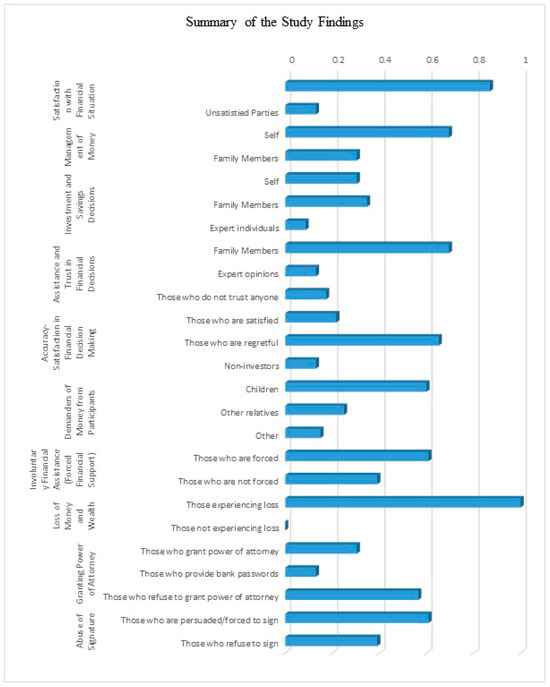
Figure 1
Open AccessArticle
Applications of the Shapley Value to Financial Problems
by
Olamide Ayodele, Sunday Timileyin Ayodeji and Kayode Oshinubi
Int. J. Financial Stud. 2025, 13(2), 80; https://doi.org/10.3390/ijfs13020080 - 7 May 2025
Abstract
Managing risk, matching resources efficiently, and ensuring fair allocation are fundamental challenges in both finance and decision-making processes. In many scenarios, participants contribute unequally to collective outcomes, raising the question of how to distribute costs, benefits, or opportunities in a justifiable and optimal
[...] Read more.
Managing risk, matching resources efficiently, and ensuring fair allocation are fundamental challenges in both finance and decision-making processes. In many scenarios, participants contribute unequally to collective outcomes, raising the question of how to distribute costs, benefits, or opportunities in a justifiable and optimal manner. This paper applies the Shapley value—a solution concept from cooperative game theory—as a principled tool in the following two specific financial settings: first, in tax cooperation games; and second, in assignment markets. In tax cooperation games, we use the Shapley value to determine the equitable tax burden distribution among three firms, A, B, and C, which operate in two countries, Italy and Poland. Our model ensures that countries participating in coalitions face a lower degree of tax evasion compared to non-members, and that cooperating firms benefit from discounted tax liabilities. This structure incentivizes coalition formation and reveals the economic advantage of joint participation. In assignment markets, we use the Shapley value to find the optimal pairing in a four-buyers and four-sellers housing market. Our findings show that the Shapley value provides a rigorous framework for capturing the relative importance of participants in the coalition, leading to more balanced tax allocations and fairer market transactions. Our theoretical insights with computational techniques highlights the Shapley value’s effectiveness in addressing complex allocation challenges across financial management domains.
Full article
Open AccessArticle
Financial Literacy and Financial Well-Being Amid Varying Economic Conditions: Evidence from the Survey of Household Economics and Decisionmaking 2017–2022
by
Vivekananda Das
Int. J. Financial Stud. 2025, 13(2), 79; https://doi.org/10.3390/ijfs13020079 - 6 May 2025
Abstract
This study examines whether the gaps in four financial well-being (FWB) indicators—emergency fund availability, spending less than income, perceived financial comfort, and no credit card debt—between groups with varying levels of financial literacy changed during the economic disruptions of 2020–2022 compared to the
[...] Read more.
This study examines whether the gaps in four financial well-being (FWB) indicators—emergency fund availability, spending less than income, perceived financial comfort, and no credit card debt—between groups with varying levels of financial literacy changed during the economic disruptions of 2020–2022 compared to the more stable period of 2017–2019. Using data from the 2017–2022 waves of the Survey of Household Economics and Decisionmaking conducted by the Federal Reserve Board, this study applies difference-in-differences and event study methods to explore these trends. Descriptive findings, consistent with prior research, show that respondents with higher financial literacy reported greater FWB across all years. Regression estimates based on respondents who provided definitive answers (correct or incorrect) to the Big Three financial literacy questions suggest that the pre-existing gaps in emergency fund availability and perceived financial comfort between respondents with higher and lower financial literacy widened in 2020–2022, whereas the gap in spending less than income remained unchanged. There is some evidence of a widening gap in the likelihood of having no credit card debt, but the estimates are less conclusive. In general, these results indicate that higher financial literacy might have served as a protective factor for some aspects of FWB amid the challenging economic conditions of 2020–2022. However, results based on respondents who provided either correct or “don’t know” answers to the same questions differ in direction from the results of the earlier analysis. The findings of this study have implications for measuring financial literacy and investigating its role in shaping FWB.
Full article
(This article belongs to the Special Issue Advance in the Theory and Applications of Financial Literacy)
►▼
Show Figures
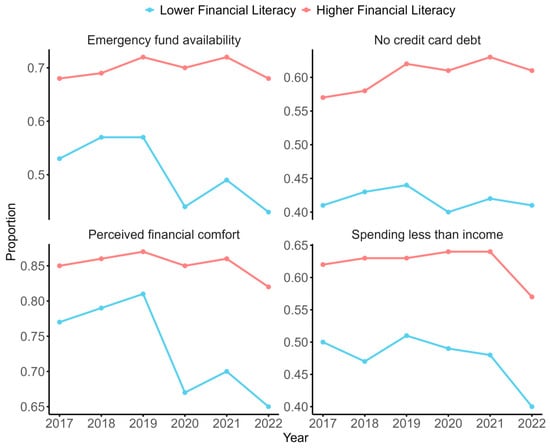
Figure 1
Open AccessArticle
Green Finance and Regional Technological Innovation in China: The Mediating Role of R&D Investment
by
Ading Li, Adul Supanut and Jianxu Liu
Int. J. Financial Stud. 2025, 13(2), 78; https://doi.org/10.3390/ijfs13020078 - 5 May 2025
Abstract
►▼
Show Figures
In light of global initiatives aimed at promoting sustainability and low-carbon growth, this research investigates how green finance affects regional technological innovation in China, specifically highlighting the mediating effect of R&D investment. Utilizing panel data from 30 provinces in China from 2008 to
[...] Read more.
In light of global initiatives aimed at promoting sustainability and low-carbon growth, this research investigates how green finance affects regional technological innovation in China, specifically highlighting the mediating effect of R&D investment. Utilizing panel data from 30 provinces in China from 2008 to 2021, we apply fixed-effects and mediation models to explore these relationships. The results indicate a strong positive link between green finance and regional technological innovation, with R&D investment acting as a partial mediator. Furthermore, the capabilities for regional innovation and entrepreneurship enhance the influence of green finance on R&D investment. However, in areas with greater innovation and entrepreneurship capabilities, the additional effect of R&D investment tends to decrease. Based on these results, the study proposes targeted policy recommendations, including enhancing green finance policies, improving financial institution services, promoting enterprise-led R&D activities, and fostering regional collaboration to achieve balanced innovation development. These insights provide both theoretical and practical significance for leveraging green finance to advance sustainable innovation.
Full article

Figure 1
Open AccessReview
Voluntary International Financial Reporting Standards Application: A Bibliometric Review and Future Research Directions
by
Ngoc Giau Nguyen and Ngoc Tien Nguyen
Int. J. Financial Stud. 2025, 13(2), 77; https://doi.org/10.3390/ijfs13020077 - 3 May 2025
Abstract
►▼
Show Figures
This study aims to review research on voluntary IFRS application and future research directions. This study presents a bibliometric review of 185 studies on voluntary IFRS application using Web of Science data and R software. Four research clusters are identified: (i) determinants of
[...] Read more.
This study aims to review research on voluntary IFRS application and future research directions. This study presents a bibliometric review of 185 studies on voluntary IFRS application using Web of Science data and R software. Four research clusters are identified: (i) determinants of IFRS voluntary application, (ii) corporate disclosure, (iii) voluntary disclosure, and (iv) economic consequences, with detailed analysis and future research question extraction. These research clusters enable us to extract future research questions, highlighting the avenues where further investigation is needed. This study provides practical insights for policymakers and practitioners. Researchers can leverage our work to grasp the current state of knowledge, identifying active and impactful research areas. This guidance can inform their investigations, though this study relies solely on data from the Web of Science database. This study provides a comprehensive overview of the existing literature on voluntary IFRS application, helping researchers, practitioners, and policymakers understand the current state of research in this field.
Full article
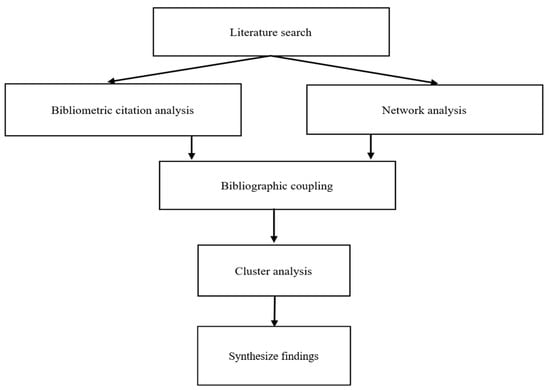
Figure 1
Open AccessArticle
The Influence of Bank Loans and Deposits on Ecuador’s Economic Growth: A Cointegration Analysis
by
Freddy Naula, Cristian Zamora and Kevin Gomez
Int. J. Financial Stud. 2025, 13(2), 76; https://doi.org/10.3390/ijfs13020076 - 2 May 2025
Abstract
►▼
Show Figures
This study examines the relationship between banking sector development (credit and deposits) and economic growth in Ecuador, using quarterly data for the period 2000–2022. An ARDL approach with Bound Test cointegration is employed, incorporating structural breaks using the Bai–Perron test and controlling for
[...] Read more.
This study examines the relationship between banking sector development (credit and deposits) and economic growth in Ecuador, using quarterly data for the period 2000–2022. An ARDL approach with Bound Test cointegration is employed, incorporating structural breaks using the Bai–Perron test and controlling for macroeconomic shocks. In addition, time transformation methodologies are applied to harmonize the frequency of the series: the monthlyization of GDP is performed using the Chow-Lin method, and the imputation of missing unemployment data using the Kalman filter. The results reveal a significant long-run elasticity between bank deposits and GDP (0.45%), while credits do not present a statistically significant effect, possibly due to high delinquency and institutional weakness. Granger causality tests confirm a unidirectional relationship between banking variables to economic growth. These findings highlight the importance of strengthening financial supervision and improving institutional quality to enhance the effect of bank intermediation. The study provides robust and contextualized empirical evidence relevant to resource-dependent economies with concentrated financial systems, contributing to the debate on the relationship between finance and growth in developing countries.
Full article

Graphical abstract
Open AccessFeature PaperArticle
Financial Sentiment Analysis and Classification: A Comparative Study of Fine-Tuned Deep Learning Models
by
Dimitrios K. Nasiopoulos, Konstantinos I. Roumeliotis, Damianos P. Sakas, Kanellos Toudas and Panagiotis Reklitis
Int. J. Financial Stud. 2025, 13(2), 75; https://doi.org/10.3390/ijfs13020075 - 2 May 2025
Abstract
Financial sentiment analysis is crucial for making informed decisions in the financial markets, as it helps predict trends, guide investments, and assess economic conditions. Traditional methods for financial sentiment classification, such as Support Vector Machines (SVM), Random Forests, and Logistic Regression, served as
[...] Read more.
Financial sentiment analysis is crucial for making informed decisions in the financial markets, as it helps predict trends, guide investments, and assess economic conditions. Traditional methods for financial sentiment classification, such as Support Vector Machines (SVM), Random Forests, and Logistic Regression, served as our baseline models. While somewhat effective, these conventional approaches often struggled to capture the complexity and nuance of financial language. Recent advancements in deep learning, particularly transformer-based models like GPT and BERT, have significantly enhanced sentiment analysis by capturing intricate linguistic patterns. In this study, we explore the application of deep learning for financial sentiment analysis, focusing on fine-tuning GPT-4o, GPT-4o-mini, BERT, and FinBERT, alongside comparisons with traditional models. To ensure optimal configurations, we performed hyperparameter tuning using Bayesian optimization across 100 trials. Using a combined dataset of FiQA and Financial PhraseBank, we first apply zero-shot classification and then fine tune each model to improve performance. The results demonstrate substantial improvements in sentiment prediction accuracy post-fine-tuning, with GPT-4o-mini showing strong efficiency and performance. Our findings highlight the potential of deep learning models, particularly GPT models, in advancing financial sentiment classification, offering valuable insights for investors and financial analysts seeking to understand market sentiment and make data-driven decisions.
Full article
(This article belongs to the Special Issue Modern Financial Econometrics)
►▼
Show Figures

Figure 1
Open AccessArticle
National Culture, Institutional Quality, and Financial Development: International Evidence Before and After Financial Crisis
by
Selma Izadi, Frankie J. Weinberg and Mamunur Rashid
Int. J. Financial Stud. 2025, 13(2), 74; https://doi.org/10.3390/ijfs13020074 - 2 May 2025
Abstract
►▼
Show Figures
This study examines the impact of Hofstede’s six cultural dimensions and institutional quality on financial development in the periods preceding and following the global financial crisis. The study analyzes data from 33 countries spanning 2001 to 2021 using a combination of OLS, two-stage
[...] Read more.
This study examines the impact of Hofstede’s six cultural dimensions and institutional quality on financial development in the periods preceding and following the global financial crisis. The study analyzes data from 33 countries spanning 2001 to 2021 using a combination of OLS, two-stage GMM, and PVAR models and concludes that inflation and economic growth negatively, and exchange rate and institutional quality positively significantly enhance financial development. Countries characterized by low masculinity and uncertainty avoidance scores, alongside high individualism and indulgence scores, tend to exhibit greater financial development. The results also indicate that cultural factors ought to be regarded as dynamic modifiers of financial development. National culture and institutional quality have a consistent influence on financial development pre- as well as post-crisis periods. Policymakers must recognize the significance of both formal and informal institutions in fostering an environment that promotes financial development and growth. A strategic integration of diverse cultural identities and values will confer a competitive advantage to nations. The effective management of cultural diversity and openness is crucial for attracting new investment, fostering innovation, comprehending the needs and skills of the workforce, and promoting financial development.
Full article

Figure 1
Open AccessArticle
Factors Affecting the Financial Sustainability of Startups During the Valley of Death: An Empirical Study in an Innovative Ecosystem
by
Cesar Zapata-Molina, Mauricio Bedoya-Villa, Johnatan Castro-Gómez, Santiago Gutiérrez-Broncano, Edith Román and Elkin Rave-Gómez
Int. J. Financial Stud. 2025, 13(2), 73; https://doi.org/10.3390/ijfs13020073 - 2 May 2025
Abstract
►▼
Show Figures
(1) Background: The survival and growth of startups in their early stages are negatively impacted by the lack of financial sustainability and scarce resources that entrepreneurs face during the first 5 years. This is known as the Valley of Death (VoD). This study
[...] Read more.
(1) Background: The survival and growth of startups in their early stages are negatively impacted by the lack of financial sustainability and scarce resources that entrepreneurs face during the first 5 years. This is known as the Valley of Death (VoD). This study seeks to identify key factors that influence the financial sustainability of startups during the VoD, which demands a significant amount of funding and government support. (2) Methods: A quantitative methodology was employed, based on a worldwide literature review that pointed out the variables of the object of study; the information collection process was conducted through a questionnaire applied to 352 entrepreneurs in an innovative ecosystem. This study empirically applies a structural equation model to determine the relationship between constructs. (3) Results: A comprehensive analysis of the results indicates that indicators such as positive sales performance, sufficient financial solvency to meet short- and long-term commitments, accurate pricing policies, and access to government and banking support are the primary factors affecting the sustainability of startups in the early stages. (4) Originality: This study provides original and relevant insights into the indicators that affect the financial sustainability of startups during the VoD and offers interesting insights for governments, institutions, and entrepreneurs to foster innovative ecosystems; it also contributes to the extant literature on early-stage entrepreneurial failures.
Full article
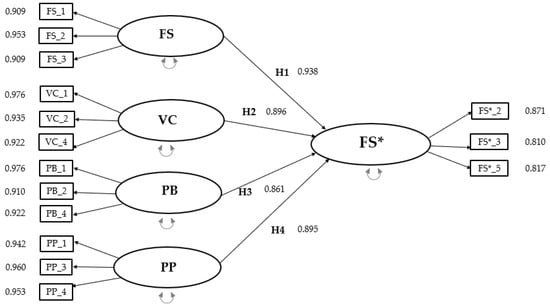
Figure 1
Open AccessArticle
Mapping Extent of Spillover Channels in Monetary Space: Study of Multidimensional Spatial Effects of US Dollar Liquidity
by
Changrong Lu, Lian Liu, Fandi Yu, Jiaxiang Li and Guanghong Zheng
Int. J. Financial Stud. 2025, 13(2), 72; https://doi.org/10.3390/ijfs13020072 - 1 May 2025
Abstract
This study aims to analyze the spatial effects triggered by dollar liquidity by constructing a multidimensional spatial matrix that modifies the traditional monetary spatial framework. We utilized a three-level spatial econometric model (Spatial Lag, Durbin, and Generalized Nested Space) to measure Gross Domestic
[...] Read more.
This study aims to analyze the spatial effects triggered by dollar liquidity by constructing a multidimensional spatial matrix that modifies the traditional monetary spatial framework. We utilized a three-level spatial econometric model (Spatial Lag, Durbin, and Generalized Nested Space) to measure Gross Domestic Product (GDP), Consumer Price Index (CPI), and Asset Price Bubbles (BBL) through five spillover channels (geography, linguistics, politics, war, and economy). Our aim is to establish a systematic relationship between the conduction mechanism, means, economic indicators, and dollar externalities to examine liquidity spillover effects at varying distances in the global monetary space. We find that the spatial effects induced by the global circulation of the US dollar behave significantly differently in a single matrix space compared to in a multidimensional space. While the model verifies the existence of a positive correlation between the complexity of a single space and the spillover effect from a conduction mechanism perspective, the measure of the multidimensional matrix shows that the significance of the spillover effect weakens with an increase in abstraction level from a conduction means perspective. It suggests that spatial matrices of different dimensions reflect different economic realities. The former shows hierarchical multivariate details in independent matrices, while the variation in the level of abstraction of matrices of different dimensions in the latter enhances their interactivity and complexity.
Full article
Open AccessArticle
Thailand Sustainability Investment Performance on Thailand’s Stock Market and Financial Assets
by
Pitipat Nittayakamolphun, Wiwatwong Bunnun, Nathaporn Phong-a-ran, Raweepan Uttarin and Panjamapon Pholkerd
Int. J. Financial Stud. 2025, 13(2), 71; https://doi.org/10.3390/ijfs13020071 - 1 May 2025
Abstract
►▼
Show Figures
Extreme weather events are the primary driver of environmental, social, and governance (ESG) responsible investment or sustainable stocks, which are gaining popularity worldwide, including in Thailand. Nevertheless, the function of sustainable stocks remains an academic dispute and without satisfactory conclusion for decision-making of
[...] Read more.
Extreme weather events are the primary driver of environmental, social, and governance (ESG) responsible investment or sustainable stocks, which are gaining popularity worldwide, including in Thailand. Nevertheless, the function of sustainable stocks remains an academic dispute and without satisfactory conclusion for decision-making of Thai investors. Thus, we adopt a dynamic conditional correlation generalized autoregressive conditional heteroskedasticity (DCC-GARCH) model to examine the influence of Thailand sustainability investment on Thailand’s stock market and financial assets. The result indicates that Thailand sustainability investment lacks hedging functions and is classified as a weak safe-haven for consumer product stocks, bitcoin, and Thai baht. Consequently, Thailand sustainability investment provides a better alternative asset for risk diversification, although volatility is low compared to other financial assets and decreases during crises. Investors are advised to diversify their investment risks by adding Thailand sustainability investment to their portfolios during a bearish market.
Full article
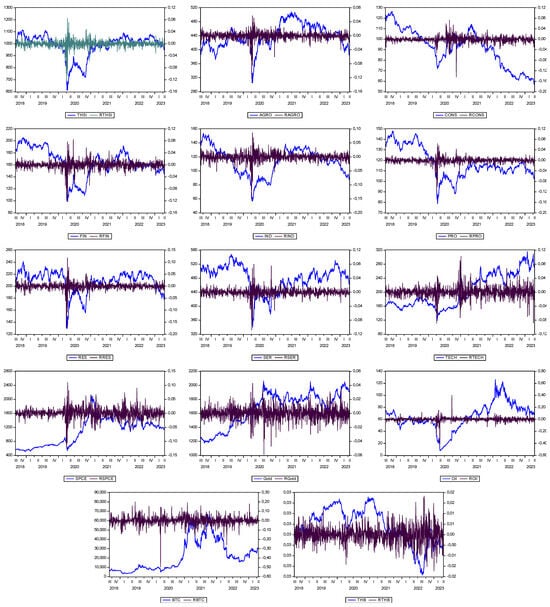
Figure 1
Open AccessArticle
The Effects of Investor Sentiment on Stock Return Indices Under Changing Market Conditions: Evidence from South Africa
by
Fabian Moodley, Sune Ferreira-Schenk and Kago Matlhaku
Int. J. Financial Stud. 2025, 13(2), 70; https://doi.org/10.3390/ijfs13020070 - 30 Apr 2025
Abstract
The objective of the study is to examine the effects of investor sentiment on the Johannesburg Stock Exchange (JSE) index returns in bull and bear market conditions. Accordingly, this study uses monthly data to construct a new market-wide investor sentiment index and test
[...] Read more.
The objective of the study is to examine the effects of investor sentiment on the Johannesburg Stock Exchange (JSE) index returns in bull and bear market conditions. Accordingly, this study uses monthly data to construct a new market-wide investor sentiment index and test its effects on the JSE aggregated and disaggregated index returns in alternating market conditions for the period March 2007 to January 2024. The findings of the Markov regime-switching model reveal that when the JSE is in a bull market condition, the JSE oil and gas sector returns and the JSE telecommunication sector returns are affected positively by investor sentiment. Similarly, in a bearish state, the JSE health sector returns and JSE telecommunication sector returns are negatively affected by investor sentiment. Collectively, the findings suggest that the effects of investor sentiment on JSE index returns are regime-specific and time-varying, such that they are dependent on the market conditions (bull or bear) and the type of JSE index (aggregated or disaggregated index). Accordingly, investors must consider this information to ensure resilient investment decisions and risk management strategies in sentiment-induced markets and alternating market conditions.
Full article
(This article belongs to the Special Issue Financial Stability in Light of Market Fluctuations)
Highly Accessed Articles
Latest Books
E-Mail Alert
News
Topics
Topic in
Agriculture, Economies, Sustainability, Urban Science, IJFS
The Multidimensional Synergy Measures to Achieve Sustainable Regional Socio-Economic Development
Topic Editors: Zaijun Li, Lei Jiang, Rufei MaDeadline: 31 December 2025
Topic in
Economies, IJFS, JRFM, Risks, Sustainability
Insurance and Risk Management Advances in the 4A Era—AI, Aging, Abruptions, and Adoptions
Topic Editors: Xiaojun Shi, Lingyan Suo, Feng Gao, Baorui DuDeadline: 30 May 2026
Topic in
Economies, IJFS, Sustainability, Businesses, JRFM
Sustainable and Green Finance
Topic Editors: Otilia Manta, Maria PalazzoDeadline: 31 October 2026

Conferences
Special Issues
Special Issue in
IJFS
Disaster Risk Finance and Insurance for Developing Economies
Guest Editor: Shaun Shuxun WangDeadline: 31 May 2025
Special Issue in
IJFS
Digital Financial Economics: Impacts of New Technologies on Financial Processes
Guest Editor: Ricardo Reier ForradellasDeadline: 31 May 2025
Special Issue in
IJFS
The Financial Economics of the Decentralized Capital Market
Guest Editors: Tamir Agmon, Ido KallirDeadline: 1 June 2025
Special Issue in
IJFS
Financial Reporting and Corporate Governance
Guest Editor: Maggie FoleyDeadline: 30 June 2025










